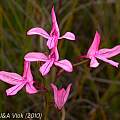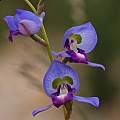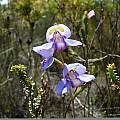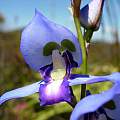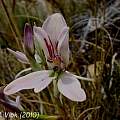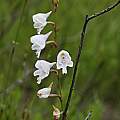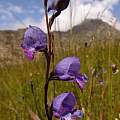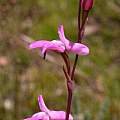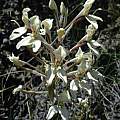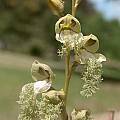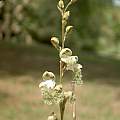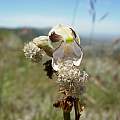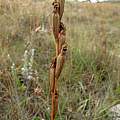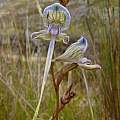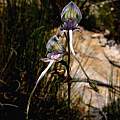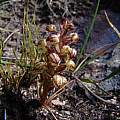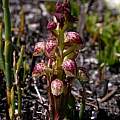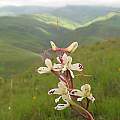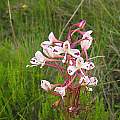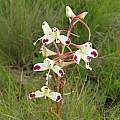Disa is a genus in the family Orchidaceae and is mostly found in southern and eastern Africa. Species are deciduous or evergreen terrestrial plants with both tuberous and stoloniferous root systems. They are found from sea level to about 7000 feet. Species g-n are found on this page.
Disa species a-ce - Disa species ch-f - Disa species o-r - Disa species s-z - Disa index
Disa gladioliflora Burch. ex Lindl. is found on grassy slopes above the forests in the Outeniqua Mountains. Narrow leaves surround the base of the stem which is about 55 cm. Flowering is in autumn (March to April). Flowers are deep pink with a darker spur and dark veining on the hood. Photo courtesy of Jan and Anne Lise Schutte-Vlok.
Disa graminifolia Ker Gawl. ex Spreng., syn. Herschelianthe graminifolia, is a species with 4 to 6 basal grasslike leaves and 2 to 6 sweetly scented flowers with bright blue to violet-purple sepals, petals that are mauve-purple and green, and a purple-violet streaked lip. It grows from .5-1 m and is found on dry sunny mountain slopes in dense vegetation in the southwestern Cape. It blooms January to March and is pollinated by carpenter bees. Photos by Ragnhild Crawford and Cameron McMaster taken at Napier in the Overberg.
Disa harveyana Lindl. is the current spelling for this species although it was named in 1842 as 'harveiana' and will still be listed in older books with that spelling. It is distributed mostly in the Southwestern Cape where it grows on sandstone slopes and flowers in summer. It has a basal tuft of narrow leaves dry at flowering and a loose spike of cream to white or mauve to lilac large flowers with purple or red streaks. The dorsal tepal does not completely enclose the petals and is drawn into a slender spur. It is pollinated by horseflies and flowers best in open areas or the first several years after a fire. Photo from the book Plants of the Klein Karoo is courtesy of Jan and Anne Lise Schutte-Vlok.
Disa hians (L.f.) Spreng., syn. Herschelianthe hians, grows from 30 to 60 cm and is found in gravely flats and sandstone slopes in the southern and southeastern Cape. It flowers from late spring to early summer, usually after fire. The few flowers in a lax raceme are pale to purple-blue with a lip darker than sepals. The first photo was taken by Cameron McMaster in the Eastern Cape. The second photo from the book Plants of the Klein Karoo is courtesy of Jan and Anne Lise Schutte-Vlok.
Disa inflexa (Lindl.) Mundt ex Bolus, syn. Schizodium inflexum, occurs from the Bokkeveld Mountains to the Eastern Cape on seasonally moist, sandy flats. It is similar to Disa bifida, but has smaller flowers with white sepals and yellow petals and lip. It flowers spring to summer on plants up to 30 cm tall. The photo below from the book Plants of the Klein Karoo is courtesy of Jan and Anne Lise Schutte-Vlok.
Disa karooica S.D.Johnson & H.P.Linder was previously included in Disa draconis (L.f.) Sw. It grows to 60 cm and has cream flowers with purple streaks on the petals. Leaves are dry at flowering. It is found in the Karoo and the Roggeveld (Kamiesberg and Sutherland). The photo was taken by Rod Saunders.
Disa lugens Bolus, syn. Herschelianthe lugens is found on sandstone slopes from the Cape peninsula to Grahamstown. Cream-green flowers appear in spring. Photos by Cameron McMaster taken in the Eastern Cape.
Disa multifida Lindl. is a widespread species found on sandstone slopes from the Cedarberg to the Swartberg Mountains. Growing up to 60 cm tall when in flower in summer, it has basal linear leaves dry at flowering. Flowers are light blue with darker blue and green markings. This species is distinctive with a very long lip. The photos below from the book Plants of the Klein Karoo are courtesy of Jan and Anne Lise Schutte-Vlok.
Disa neglecta Sond. is found on sandstone slopes in the Western Cape. Growing to 18 cm with narrow lanceolate leaves, it flowers November to December after fire. Flowers are dull yellow and purple. Photos from Jan and Anne Lise Schutte-Vlok.
Disa nervosa Lindl. is found in rocky grassland from the Eastern Cape to Mpumalanga. Growing to 80 cm, it has slender leaves and bright pink flowers with dense purple spots at the petal tips. The flowers are held horizontally and the lip is long and narrow. This species blooms in summer to early fall. Photo by Rod Saunders.
Disa nivea H.P.Linder is found on moist grassy slopes and rock ledges in the Drakensberg at 2250-2500 m. It grows from 20 to 40 cm and has creamy white flowers with dark red blotches at the tips of the sepals and lip and a speckled dark red spur. It blooms in summer. Photos were taken by Cameron McMaster at Aurora Peak, Maclear, February 2008.
Disa species a-ce - Disa species ch-f - Disa species o-r - Disa species s-z - Disa index
